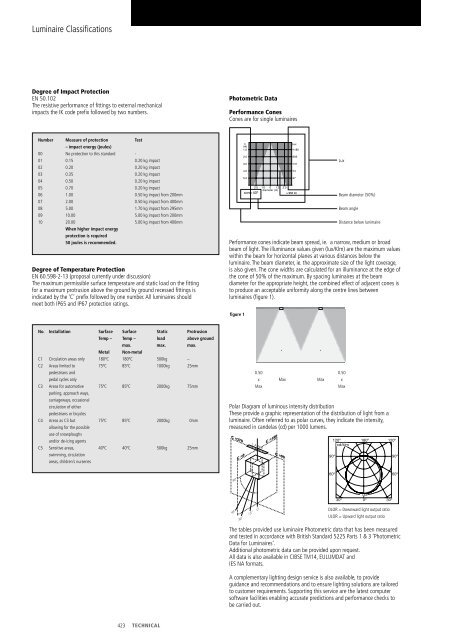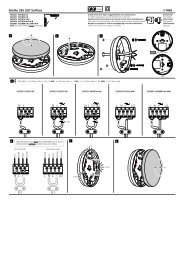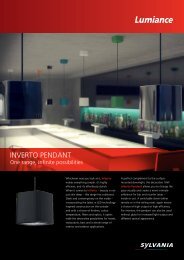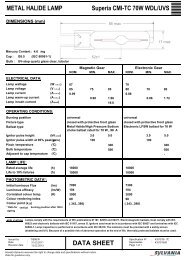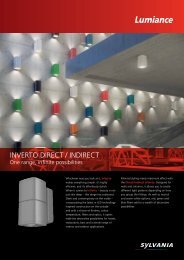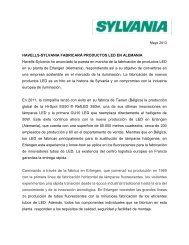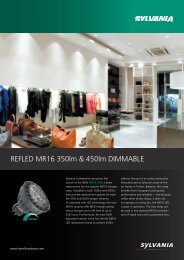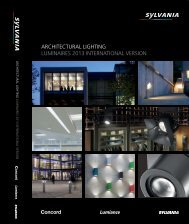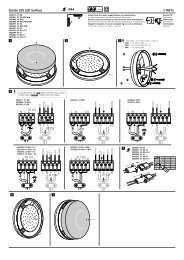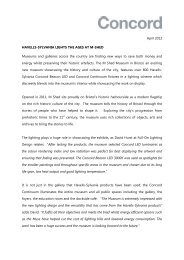Create successful ePaper yourself
Turn your PDF publications into a flip-book with our unique Google optimized e-Paper software.
Luminaire Classifications<br />
Degree of Impact Protection<br />
EN 50.102<br />
The resistive performance of fittings to external mechanical<br />
impacts the IK code prefix followed by two numbers.<br />
Number Measure of protection<br />
– impact energy (joules)<br />
Test<br />
00 No protection to this standard -<br />
01 0.15 0.20 kg impact<br />
02 0.20 0.20 kg impact<br />
03 0.35 0.20 kg impact<br />
04 0.50 0.20 kg impact<br />
05 0.70 0.20 kg impact<br />
06 1.00 0.50 kg impact from 200mm<br />
07 2.00 0.50 kg impact from 400mm<br />
08 5.00 1.70 kg impact from 295mm<br />
09 10.00 5.00 kg impact from 200mm<br />
10 20.00<br />
When higher impact energy<br />
protection is required<br />
50 joules is recommended.<br />
5.00 kg impact from 400mm<br />
Degree of Temperature Protection<br />
EN 60.598-2-13 (proposal currently under discussion)<br />
The maximum permissible surface temperature and static load on the fitting<br />
for a maximum protrusion above the ground by ground recessed fittings is<br />
indicated by the ‘C’ prefix followed by one number. All luminaires should<br />
meet both IP65 and IP67 protection ratings.<br />
No. Installation Surface Surface Static Protrusion<br />
Temp – Temp – load above ground<br />
max. max. max.<br />
Metal Non-metal<br />
C1 Circulation areas only 180ºC 180ºC 500kg –<br />
C2 Areas limited to<br />
pedestrians and<br />
pedal cycles only<br />
75ºC 85ºC 1000kg 25mm<br />
C3 Areas for automotive<br />
parking, approach ways,<br />
carriageways, occasional<br />
circulation of either<br />
pedestrians or bicycles<br />
75ºC 85ºC 2000kg 75mm<br />
C4 Areas as C3 but<br />
allowing for the possible<br />
use of snowploughs<br />
and/or de-icing agents<br />
75ºC 85ºC 2000kg 0mm<br />
C5 Sensitive areas,<br />
swimming, circulation<br />
areas, children’s nurseries<br />
40ºC 40ºC 500kg 25mm<br />
423 TECHNICAL<br />
Photometric Data<br />
Performance Cones<br />
Cones are for single luminaires<br />
Performance cones indicate beam spread, ie. a narrow, medium or broad<br />
beam of light. The illuminance values given (lux/Klm) are the maximum values<br />
within the beam for horizontal planes at various distances below the<br />
luminaire. The beam diameter, ie. the approximate size of the light coverage,<br />
is also given. The cone widths are calculated for an illuminance at the edge of<br />
the cone of 50% of the maximum. By spacing luminaires at the beam<br />
diameter for the appropriate height, the combined effect of adjacent cones is<br />
FIG 4.<br />
to produce an acceptable uniformity along the centre lines between<br />
luminaires (figure 1).<br />
figure 1<br />
0.50<br />
x<br />
Max<br />
Polar Diagram of luminous intensity distribution<br />
These provide a graphic representation of the distribution of light from a<br />
luminaire. Often referred to as polar curves, they indicate the intensity,<br />
FIG 8.<br />
measured in candelas (cd) per 1000 lumens.<br />
C =270<br />
90˚<br />
45˚<br />
C =0<br />
L A M P<br />
30˚ 15˚ 0<br />
C =180<br />
Max Max<br />
C =90<br />
The tables provided use luminaire Photometric data that has been measured<br />
and tested in accordance with British Standard 5225 Parts 1 & 3 ‘Photometric<br />
Data for Luminaires’.<br />
Additional photometric data can be provided upon request.<br />
All data is also available in CIBSE TM14, EULUMDAT and<br />
IES NA formats.<br />
A complementary lighting design service is also available, to provide<br />
guidance and recommendations and to ensure lighting solutions are tailored<br />
to customer requirements. Supporting this service are the latest computer<br />
software facilities enabling accurate predictions and performance checks to<br />
be carried FIG out. 9.<br />
Lux<br />
Beam diameter (50%)<br />
Beam angle<br />
Distance below lunimaire<br />
0.50<br />
x<br />
Max<br />
120º<br />
cd/klm<br />
90º<br />
60º<br />
180º<br />
120º<br />
30º<br />
135<br />
0º 30º<br />
DLOR = Downward light output ratio<br />
ULOR = Upward light output ratio<br />
90º<br />
60º


